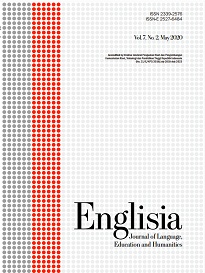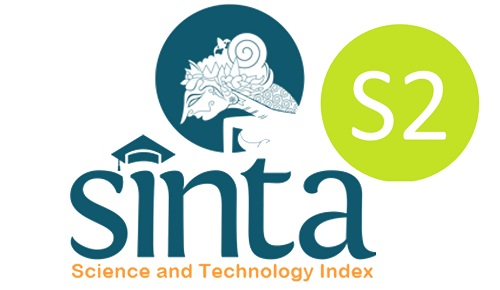Music(s) of the world as an online EFL resource: A Japanese EFL classroom experience
DOI:
https://doi.org/10.22373/ej.v7i2.6325Keywords:
Music, Performance in education, ethnomusicology, EFL, multimedia, CALLAbstract
This research considers how the study of musical performances from around the world can be drawn upon as a useful resource for language instruction, particularly in EFL Japanese university classrooms. This study shares the insights gained from literature reviews combined with the researcher’s teaching experiences on the advanced English elective course of “Computer-Assisted Ethnomusicology.” This work was carried out over a five-year period between 2013 - 2018 at a university in the Tohoku region of Japan, based on a course that focused on the music and culture found in Oceania, South East Asia, East Asia, Africa, and North America. This study identifies the language resources present within the ethnomusicological content, and identifies the ways it can help awaken learners to the rich variation that exists among the cultures of the world, and highlighting the way local and global features combine in the ‘glocal’. In addition to digital applications, approaches introduced in the study also include the combination of high and low contact activities based on ethnomusicological resources. This helps to emphasize how Massive Open Online Courses (MOOCs), and open-source multimedia make it possible to approach musical song texts and discourses that surround musical practice and performance and apply these to EFL teaching.
Downloads
References
Abdulrahman, T., Azizah, F., & Astiyandha, T. (2019). The benefits and challenges of dramatic performance as a final project of drama course. Proceeding ASEAN Youth Conference.
Atkins, L., & Wallace, S. (2012). Qualitative research in education: SAGE publications.
Baldwin, J. J. (2019). Languages other than English in Australian Higher Education: Policies, provision, and the national interest. Switzerland: Springer.
Barton, G. (2018). Music Learning and Teaching in Culturally and Socially Diverse Contexts: Implications for classroom practice. Brisbane, Australia: Palgrave Macmillan.
Chen, D. L. (2016). Designing an experimental platform for a split-classroom comparison study. Massachusetts Institute of Technology.
Downes, E., Wold, J., Belatchew, M., Mustafa, A., & Blount, S. (2017). Strengthening educational capacity through context-relevant curriculum design and evaluation. Paper presented at the Frontiers in Education.
Engh, D. (2013). Why use music in English language learning? A survery of the literature. English Language Teaching, 6(2), 113-127.
Espindola, E., & Vasconcellos, M. L. (2006). Two facets in the subtitling process: Foreignisation and/or domestication procedures in unequal cultural encounters. Fragmentos: Revista de Língua e Literatura Estrangeiras, 30, 43-66.
Galloway, N., & Rose, H. (2018). Incorporating global Englishes into the ELT classroom. ELT Journal, 72(1), 3-14.
Gaudart, H. (1990). Using drama techniques in language teaching. Language Teaching Methodology for the Ninetees Anthology Series, 24, 230-249.
Habiburrahim, H., Rahmiati, Z., Muluk, S., Akmal, S., & Aziz, Z. A. (2020). Language, identity, and ideology: Analysing discourse in Aceh sharia law implementation. Indonesian Journal of Applied Linguistics, 9(3), 599-607.
Heift, T. (2017). History and key developments in intelligent computer-assisted language learning (ICALL). In Thorne, S.L., & May, S (Eds.), Language, education and technology, (pp. 289-300). Switzerland: Springer
Heigham, J., & Croker, R. (2009). Qualitative research in applied linguistics: A practical introduction. New York: Palgrave Macmillan.
Holden, S. (1984). Drama in Language Teaching. Longman.
Keller, P. E. (2007). Musical ensemble synchronisation. Paper presented at the Proceedings of the inaugural international conference on music communication science.
Kelsen, B. (2009). Teaching EFL to the iGeneration: A survey of using YouTube as supplementary material with college EFL students in Taiwan. Call-EJ Online, 10(2), 1-18.
Kharismawati, R., & Susanto. (2014). Suggestopedia method in the teaching and learning process. RETAIN, 2(1), 1-11.
Knight, R. C. (2015). The knight revision of Hornbostel-Sachs: a new look at musical instrument classification. Oberlin College Conservatory of Music.
Lassegard, J. P. (2013). Student perspectives on international education: An examination into the decline of Japanese studying abroad. Asia Pacific Journal of Education, 33(4), 365-379.
Lassegard, J. P. (2016). Educational diversification strategies: Japanese universities' efforts to attract international students. In Ng, C.C., Fox, R., & Nakano, M. (Eds.), Reforming learning and teaching in Asia-Pacific universities. (47-75). Singapore: Springer.
Lee, O., Goggins, M., Haas, A., Januszyk, R., Llosa, L., & Grapin, S. (2019). Making everyday phenomena phenomenal. Culturally and linguistically diverse learners and STEAM: Teachers and Researchers Working in Partnership to Build a Better Tomorrow, 211.
Levy, M., & Stockwell, G. (2013). CALL dimensions: Options and issues in computer-assisted language learning. New Jersey: Routledge.
Lian, A. (2004). Technology-enhanced language-learning environments: A rhizomatic approach. Computer-assisted Language Learning: Concepts, Contexts and Practices, 1-20.
Ma, F. (2015). A review of research methods in EFL education. Theory and Practice in Language Studies, 5(3), 566-571.
McKinley, J., & Rose, H. (2019). The routledge handbook of research methods in applied linguistics. Oxon: Routledge
Merriam, A. P., & Merriam, V. (1964). The anthropology of music. Illinois: Northwestern University Press.
Mishima, M. (2017). Is native-speakerism dead?: Japanese English language learners' perceptions about ideal English accents to learn. The Journal of Rikkyo University Language Center, 38, 49-61.
Mover, J. A. (2017). Note by note language learning: The potential of a music-centered ESL pedagogy (Doctoral dissertation, faculty of graduate studies and research in partial fulfillment of the requirements for the degree of Master of Arts school of linguistics and language studies, Carleton University).
Moyle, R. (1974). Samoan musical instruments. Ethnomusicology, 57-74.
Nadera, B. (2015). Promoting students motivation in EFL classroom: Through extended music education. Procedia – Social and Behavioral Sciences, 199(2015), 368-371.
Nakaya, A. (2018). Overcoming ethnic conflict through multicultural education: The case of West Kalimantan, Indonesia. International Journal of Multicultural Education, 20(1), 118-137.
Nunan, D. (2003). The impact of English as a global language on educational policies and Practices in the Asia‐Pacific region. TESOL Quarterly, 37(4), 589-613.
Ortega, E. S. (2011). Subtitling and the relevance of non-verbal information in polyglot films. New Voices in Translation Studies, 7, 19-34.
Pennycook, A. (2003). Global Englishes, rip slyme, and performativity. Journal of Sociolinguistics, 7(4), 513-533.
Place, A., Lacey, L., Mitchell, T., Place, A., Lacey, L., & Mitchell, T. (2014). AlphaSphere from prototype to product. Paper presented at the NIME.
Pugh-Kitingan, J. (2017). Transmitting intangible cultural heritage through ethnomusicology coursework: Cases from Sabah, Malaysia. In Barton, G., & Baguley, M. (Eds), The Palgrave Handbook of Global Arts Education, (pp. 331-347), London: Palgrave Macmillan.
Read, S. (2003). Applications of case study research. Nurse Researcher, 10(4), 93-95.
Rockell, K. (2015a). Interactive musical composition using a looping app to support L2 development. Paper presented at the Digital Arts, Oxford, United Kingdom.
Rockell, K. (2015b). Musical looping of lexical chunks: An exploratory study. JALT CALL Journal, 11(3).
Rockell, K. (2016). Incorporating music in CALL: An exploratory study establishing a protocol for computer assisted language learning incorporating music (CALLiM). ACOJ.
Rockell, K. (2018). English Noh theater workshop: Lessons from a Japanese university EFL classroom. The Mask & Gavel, 7, 38-49.
Rockell, K. (2019). The coding catastrophe: Translingualism and Noh in the Japanese computer science EFL classroom. In T. Barrett & S. Dovchin (Eds.), Critical Inquiries in the Sociolinguistics of Globalization. Bristol, UK: Multilingual Matters.
Rockell, K. (2020). Knowing Noh and 'Nō-ing' English through intercultural performing arts. International Journal of Education & the Arts, 21(11).
Rockell, K., & Ocampo, M. (2014). Musicians in the language classroom: The transference of musical skills to teach "Speech Mode of Communication". ELTED, 16(Spring), 34-37.
Sembiring, B. S. B., & Sarwono, S. (2018). Respondents' views on English drama in indigenous theatre: A case of English cultivation within Kachru's expanding circle. Journal of Education and Human Development, 7(2), 76-85.
Subandiyah, H., Yulianto, B., & Laksono, K. (2019). The importance of developing Indonesian language learning materials based on local culture for BIPA students. Paper presented at Social Sciences, Humanities and Education Conference (SoSHEC 2019). Atlantis Press.
Sugimoto, J., & Uchida, Y. (2018). How pronunciation is taught in English textbooks published in Japan. Seishin Studies, 130, 3-35.
Susser, B. (2017). Rating English-medium instruction degree programs at Japanese universities. Transformation in language education. Tokyo: JALT.
Wood, A. (2008). E-fieldwork: A paradigm for the twenty-first century? The New (ethno) Musicologies, 8, 170.
Yaghoobi, M., & Razmjoo, S.A. (2016). The potentiality of computer-assisted instruction towards ameliorating Iranian EFL learners' reading level. Computers in Human Behavior, 59, 108-114.
Younus, N., & Ahmad, M. (2017). A case study on the need of using sugestopedia in EFL/ESL classes in Pakistan. Al-Qalam, 22(1), 27-37.
Yusny, R. (2013). ELT in Indonesian context: Issues and challenges. Englisia: Journal of Language, Education, and Humanities, 1(1), 81-99.
Zaid, M. A. (2014). Using suggestopedia in ELT in Saudi Arabia: Implications for pedagogy. Paper presented at international conference on economics, education and humanities (ICEEH'14), Bali, Indonesia.
Downloads
Additional Files
Published
Issue
Section
License
Proposed Policy for Journals That Offer Open Access
Authors who publish with Englisia journal agree to the following terms:
- Authors retain copyright and grant the journal right of first publication with the work simultaneously licensed under a Creative Commons Attribution License that allows others to share the work with an acknowledgement of the work's authorship and initial publication in this journal.
- Authors are able to enter into separate, additional contractual arrangements for the non-exclusive distribution of the journal's published version of the work (e.g., post it to an institutional repository or publish it in a book), with an acknowledgement of its initial publication in this journal.
- Authors are permitted and encouraged to post their work online (e.g., in institutional repositories or on their website) prior to and during the submission process, as it can lead to productive exchanges, as well as earlier and greater citation of published work (See The Effect of Open Access).









